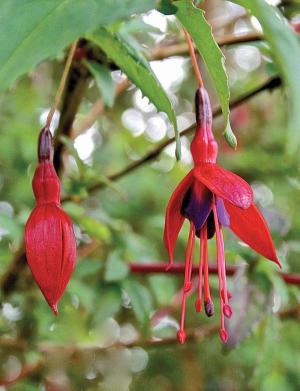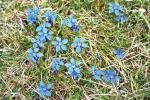April 2, 2015
By Judy Enright
Special to the BIR
It’s April at last, after a seemingly endless winter, and Ireland is exploding with spring color. Daffodils have popped up everywhere, fields are turning the delicious 40 shades of green, and gardens and hedgerows are springing back to life.
This is the loveliest time of year in Ireland for so many reasons. Weather is usually pleasant even if it rains and, of course, there are few things cheerier or more uplifting than the effervescence of newborn animals frolicking through the pastures. It’s just a happy, bright, wonderful time of year.
Cities, too, experience the renewed vitality when visitor attractions reopen and activities start up again to welcome spring –and tourists.
 What could be more Irish than the brilliant red, purple and pink fuchsia that grows wild in hedges all across the country?
What could be more Irish than the brilliant red, purple and pink fuchsia that grows wild in hedges all across the country?
GARDENS AND MORE
If you enjoy flowers and gardens, you will be in your glory in Ireland. There are numerous organized garden trails and tours in most counties in the North and in the Republic that offer entry to the most spectacular gardens, many of which are private and not open to the public except at this special time of year. Visitors should always check opening times for whatever gardens they wish to see. Local tourist information offices (online at discoverireland.ie in the Republic) and the Northern Ireland Tourist Board (online at discovernorthernireland.com) have all that information. Many of the participating gardens and homes also have websites that list hours and admission fees if any.
One group - “Houses, Castles and Gardens of Ireland” – includes more than 70 member properties in the North and Republic that are open to the public. It’s fun to visit the gardens and also fascinating to get inside the historic homes.
One attraction gardeners should not miss when they’re in Dublin is the National Botanic Gardens, in Glasnevin, with its amazing glasshouses and the Great Palm House with its exotic plants from around the world.
Entry is free and the Botanic Gardens are open Monday to Friday from 9 a.m. to 5 p.m., and on Saturday, Sunday and public holidays from 10 a.m. to 6 p.m. There are free guided tours every Sunday at noon and 2:30 p.m. See botanicgardens.ie for more.
Another property listed in “Houses, Castles and Gardens of Ireland,” is Kylemore Abbey in Connemara, which was built as a residence by a wealthy Englishman in the 1860s. In 1920, Kylemore became home to a community of Benedictine nuns who ran a girls’ school there from 1923 until 2010.
Kylemore is the most popular tourist attraction in the West of Ireland and a perfect family destination that offers an outstanding craft and design shop, a Gothic church, a children’s play trail, a coffee shop, a teahouse, and an excellent restaurant on site. There’s also a restored six-acre walled garden that is well worth the price of admission. The gardens were built at the end of the 1860s and are reputed to be Ireland’s only gardens built on bogland.
The Glasnevin Botanical Gardens and Kylemore are just two of many properties open to the public. Others showcase world-famous flowers, landscaped parklands, formal, kitchen, walled, and cottage gardens, mazes, forestry and river walks, and arboreta.
Be sure to visit hcgi.ie for details on others that include: Castlecoote House and Gardens, Co. Roscommon; Japanese Gardens and St. Fiachra’s Garden, Co. Kildare; Birr Castle Demesne, Co. Offaly; Castle Durrow Hotel Gardens, Co.Laois; Hunter’s Hotel gardens and Powerscourt House and Gardens, Co. Wicklow; gardens at Gregan’s Castle Hotel and the Vandeleur Walled Garden, both in Co. Clare; Fota House Arboretum and Gardens, Co. Cork. Another great attraction in the Cork area, even though it’s not a garden, is the Fota Wildlife Park.
 Blue Gentian flowers in the spring in the Burren's limestone landscape in Co. Clare. Judy Enright photo
Blue Gentian flowers in the spring in the Burren's limestone landscape in Co. Clare. Judy Enright photo
There are magnificent gardens and stately homes open to the public in the North, too. Don’t miss Rowallane Garden or the Mt. Stewart House and Gardens, Co. Down, and Springhill House and Costume Collection, Co. Londonderry. Many of the gardens are also opened for events such as concerts, craft and plant fairs, and more.
LISMORE CASTLE
Another lovely garden is at Lismore Castle in Co. Waterford, which is open daily mid-April to October from 10:30 a.m. to 5:30 p.m. Visitors may wander through the seven-acre historic gardens surrounded by 17th-century walls. In addition to the variety of camellias, plants and trees, and a famed yew walk, visitors may view a permanent sculpture collection. Lismore itself is a private residence with no public access, but the castle can be rented as a luxury accommodation.
If you have the opportunity to visit Co. Donegal, Glenveagh National Park is a great place to spend the day. The gardens are beautiful and there’s an excellent guided tour of the 19th-century castle, last owned by American Henry McIlhenny, an art connoisseur and plant collector. He designed and oversaw the gardens from 1937-1983, sold the acreage for the park to the Irish state in 1974-75, and gave Glenveagh Castle and gardens to Ireland in 1979.
There are many magnificent gardens around Ireland, so do get out and enjoy them.
YOLA FARMSTEAD, FOLK PARK
Yola Farmstead and Folk Park in Tagoat, Rosslare, Co. Wexford, is a fun and interesting family activity. The five-acre park now includes the Wexford Genealogy Center, which offers a fulltime, professional genealogy service for those wishing to trace their Wexford ancestry. The center has collected a considerable amount of this material and provides a fulltime professional genealogy service.
At Yola, you can see a one-bedroom thatched cottage, a working windmill, a forge, four-pew St. Helen’s Church, and stop to have a bite to eat in Granny’s Kitchen. The farmstead is home to many breeds and species of animals, fowl, and plant life. Yola is open 10 a.m. to 4:30 p.m., Monday to Friday, in April and 10 to 6 daily from May to October. For more information see: familyfun.ie/yola-farmstead
And, while you’re in that area, be sure to stop by the 622-acre John F. Kennedy Memorial Park and Arboretum in New Ross – included as part of the Wexford Garden Trail - where you’ll see an amazing variety of trees and shrubs as well as magnolia, rhododendron, azalea, and heather. More than 4,500 individual species and varieties, some rare, have been planted and there will ultimately be more than 6,000. There’s a shop and café, a visitor center, a miniature railway, a pony-and-trap, and more.
Nearby – in Dunganstown – is the Kennedy Homestead, the ancestral home of President John F. Kennedy’s great-grandparents, Patrick and Bridget (Murphy) Kennedy, who emigrated to the United States during the famine years. The Dunbrody Famine ship, moored in New Ross, is also worth a visit.
ST. PATRICK’S CAMINO
Not to be outdone by the Camino de Santiago de Compostela – a pilgrimage route in northwestern Spain that attracts some 250,000 annually - two businessmen from either side of the border have launched an Irish version.
The St. Patrick’s Camino will eventually stretch from Downpatrick, Co. Down, (where St. Patrick, St. Columba, and St. Brigid are buried) to Croagh Patrick, outside Westport in Co. Mayo. The way has been designed as a self-guided walking trail and designers hope it will attract thousands, rival the Camino de Santiago, and increase tourism in an area of scenic beauty too often overlooked by tourists.
TRAVEL
Off-road walking/cycling routes have become immensely popular in Ireland and other countries across Europe along with varied sport and adventure pursuits for the active traveler.
Be sure to check the Irish Tourist Board’s excellent website – ireland.com – for updated information on activities, accommodations, and more. And enjoy Ireland whenever you visit and wherever you go.

